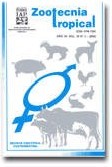
|
Zootecnia Tropical
Instituto Nacional de Investigaciones Agrícolas Venezuela
ISSN: 0798-7269
Vol. 22, No. 2, 2004, pp. 201-208
|
 Bioline Code: zt04016
Bioline Code: zt04016
Full paper language: Spanish
Document type: Research Article
Document available free of charge
|
|
|
Zootecnia Tropical, Vol. 22, No. 2, 2004, pp. 201-208
| en |
Cutaneous appendixes in the venezuelan creole goat population
Fidel. A. Pariacote, Leyberth Ruiz, y Xiomara Pimentel
Abstract
The cutaneous appendixes are visible characteristics of genetic origin that are most useful in animal husbandry. The frequency of wattled, horned, curled and bearded individuals was evaluated in the base population of a project on conservation and improvement of the Creole goat. The nuclei of the project are localized in regions geographically distantly and genetically less related to each other than the average and conformed by adult females randomly selected in a frequency of 80 heads per herd. Flocks are of the most typical and representative of each region.. The selected animals were characterized and coded with 1 and 0 for the presence or absence of wattles, horns, curl and beard, respectively. Records were also classified by region: Paraguaná, Pedregal, and Carora, Venezuela; direct fraction of genes coming from the Creole, Alpine, Nubian, Canaria, and other breeds; and buck sires (n=13). A buck's directory was created as far ago as it was possible, and from there groups of half sib progeny. An univariate analysis of the variance for the presence or absence of wattles, horns, curl and beard was done using the Proc. Mixed of SAS. The statistical model included region and buck sire as random effects, and the covariables fraction of genes of the different breeds as fixed effects. The raw frequency of horned individuals seems to correspond with results from European native goats, but the frequency of wattled and bearded individuals observed in this study seems to be higher and lower, respectively, regarding European native goats. A statistically significant difference at least between two regions was observed for all variables. The variance associated with buck sire was superior to the regions' variance. More studies are needed to determine the source of the differences.
Keywords
goat, Creole, cutaneous appendixes.
|
| |
| es |
Características fanerópticas en el caprino criollo venezolano
Fidel. A. Pariacote, Leyberth Ruiz, y Xiomara Pimentel
Resumen
Las faneras son características visibles de origen genético que pueden ser muy útil en la producción animal. La frecuencia de faneras es evaluada en la población base de un Proyecto de Conservación y Mejora Genética del Caprino Criollo. Los núcleos controles del proyecto están localizados en regiones geográficamente distantes y genéticamente menos emparentadas entre sí que el promedio, y conformados por rebaños representativos de cada región. Un total de 80 hembras adultas por rebaño fue seleccionado en forma aleatoria, caracterizado, y codificado con 1 y 0 para la presencia o ausencia de mamelas, cuernos, bucle, y barba. Los archivos también fueron clasificados por región: Paraguaná, Pedregal, y Carora; fracción directa de genes provenientes del Criollo, Alpino, Nubian, Canaria, y otras razas; y chivato padre (n = 13). Las variables evaluadas fueron sometidas a un análisis de variancia uni-variado usando el Proc Mixed de SAS. El modelo estadístico incluyó los efectos de región y chivato padre como aleatorios, y las co-variables fracción de genes de las diferentes razas como efectos fijos. La frecuencia de individuos con cuernos parece corresponder con lo observado en poblaciones nativas europeas, pero la frecuencia de mamelas y barba parecen mayor y menor, respectivamente. Todas las variables difirieren significativamente entre regiones. Más estudios son necesarios para determinar la fuente de las diferencias.
Palabras-clave
Caprino, criollo, características fanerópticas.
|
| |
© Copyright 2004 - Zootecnia Tropical.
Alternative site location: http://www.sian.inia.gob.ve/repositorio/revistas_ci/ZootecniaTropical/ztindice.htm
|
|
